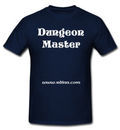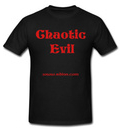Odyson
PUN-dit
Karma: 158/25
6327 Posts

|
Drow.........
Here's some 2.0 information about Drow........
Combat: The drow's world is one in which violent conflict is part of everyday life. It should not be surprising then, that most drow encountered, whether alone or in a group, are ready to fight. Drow encountered outside of a drow city are at least 2nd-level fighters. (See Society note below.)
Drow wear finely crafted, non-encumbering, black mesh armor. This extremely strong mail is made with a special alloy of steel containing adamantite. The special alloy, when worked by a drow armorer, yields mail that has the same properties of chain mail +1 to +5, although it does not radiate magic. Even the lowliest drow fighters have, in effect, chain mail +1, while higher level drow have more finely crafted, more powerful, mail. (The armor usually has a+1 for every four levels of experience of the drow wearing it.)
Dark elves also carry small shields (bucklers) fashioned of adamantite. Like drow armor, these special shields may be + 1,+2, or even+3, though only the most important drow fighters have+3 bucklers.
Most drow carry a long dagger and a short sword of adamantite alloy. These daggers and swords can have a+1 to + 3 bonus, and drow nobles may have daggers and swords of +4 bonus. Some drow (50%) also carry small crossbows that can be held in one hand and will shoot darts up to 60 yards. The darts only inflict 1-3 points of damage, but dark elves commonly coat them with poison that renders a victim unconscious, unless he rolls a successful saving throw vs. poison, with a -4 penalty. The effects last 2d4 hours.
A few drow carry adamantite maces (+ 1 to+5 bonus) instead of blades. Others carry small javelins coated with the same poison as the darts. They have a range of 90 yards with a short range bonus of+3, a +2 at medium, and a +1 at long.
Drow move silently and have superior infravision (120 feet). They also have the same intuitive sense about their underground world as dwarves do, and can detect secret doors with the same chance of success as other elves. A dark elf can only be surprised by an opponent on a roll of 1 on ldl0.
All dark elves receive training in magic, and are able to use the following spells once per day: dancing lights, faerie fire, and darkness. Drow above 4th level can use levitate, know alignment, and detect magic once per day. Drow priests can also use detect lie, clairvoyance, suggestion, and dispel magic once per day.
Perhaps it is the common use of magic in drow society that has given the dark elves their incredible resistance. Drow have a base resistance to magic of 50%, which increases by 2% for each level of experience. (Multi-classed drow gain the bonus from only the class in which they have the highest level.) All dark elves save vs. all forms of magical attack (including devices) with a+2 bonus. Thus, a 5th-level drow has a 60% base magic resistance and a +2 bonus to her saving throws vs. spells that get past her magic resistance.
Drow encountered in a group always have a leader of a higher level than the rest of the party. If 10 or more drow are encountered, a fighter/mage of at least 3rd level in each class is leading them. If 20 drow are encountered, then, in addition to the higher level fighter/mage, there is a fighter/priest of at least the 6th level in both classes. If there are more than 30, up to 50% are priests and the leader is at least a 7th-level fighter/8th-level priest, with a 5th-level fighter/4th-level mage for an assistant, in addition to the other high level leaders.
Dark elves do have one great weakness+bright light. Because the drow have lived so long in the earth, rarely venturing to the surface, they are no longer able to tolerate bright light of any kind. Drow within the radius of a light or continual light spell are 90% likely to be seen. In addition, they lose 2 points from their Dexterity and attack with a -2 penalty inside the area of these spells. Characters subject to spells cast by drow affected by a light or continual light spell add a +2 bonus to their saving throws. If drow are attacking a target that is in the area of effect of a light or continual light spell, they suffer an additional -1 penalty to their attack rolls, and targets of drow magical attacks save at an additional+1. These penalties are cumulative (i.e., if both the drow and their targets are in the area of effect of a light spell, the drow suffer a -3 penalty to their attack rolls and the targets gain a +3).
Because of the serious negative effects of strong light on the drow, they are 75% likely to leave an area of bright light, unless they are in battle. Light sources like torches, lanterns, magical weapons, or faerie fire spells, do not affect drow.
Direct sunlight utterly destroys drow cloth, boots, weapons, and armor. When any item produced by them is exposed to the light of the sun, irreversible decay begins. Within 2d6 days, the items lose their magical properties and rot, becoming totally worthless. Drow artifacts, protected from sunlight, retain their special properties for ld20+30 days before becoming normal items. If a drow item is protected from direct sunlight and exposed to the radiations of the drow underworld for one week out of every four, it will retain its properties indefinitely.
Drow sleep poison, used on their darts and javelins, is highly prized by traders on the surface. However, this poison loses its potency instantly when exposed to sunlight, and remains effective for only 60 days after it is exposed to air. Drow poison remains potent for a year if kept in an unopened packet.
Posted on 2016-01-14 at 19:18:48.
|

 Random RPG Thoughts
Random RPG Thoughts Some news about Tiamat577
Some news about Tiamat577 Shadows of the Empire
Shadows of the Empire
